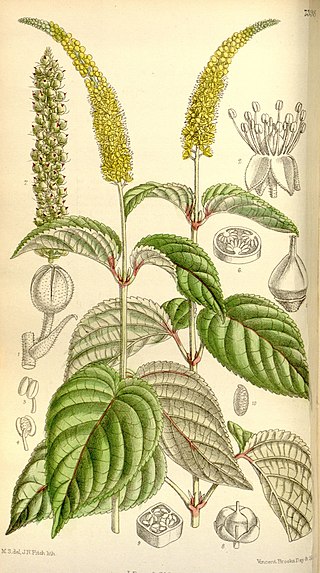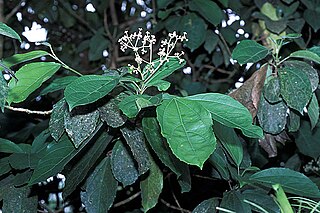
The Malpighiales comprise one of the largest orders of flowering plants, containing about 36 families and more than 16,000 species, about 7.8% of the eudicots. The order is very diverse, containing plants as different as the willow, violet, poinsettia, manchineel, rafflesia and coca plant, and are hard to recognize except with molecular phylogenetic evidence. It is not part of any of the classification systems based only on plant morphology. Molecular clock calculations estimate the origin of stem group Malpighiales at around 100 million years ago (Mya) and the origin of crown group Malpighiales at about 90 Mya.

The Salicaceae is the willow family of flowering plants. The traditional family included the willows, poplar, aspen, and cottonwoods. Genetic studies summarized by the Angiosperm Phylogeny Group (APG) have greatly expanded the circumscription of the family to contain 56 genera and about 1220 species, including the Scyphostegiaceae and many of the former Flacourtiaceae.

Xylosma is a genus of flowering plants in the family Salicaceae. It contains around 100 species of evergreen shrubs and trees commonly known as brushhollies, xylosmas, or, more ambiguously, "logwoods". The generic name is derived from the Greek words ξύλον (xylon), meaning "wood, tree", and ὀσμή (osmé), meaning "smell", referring to the fragrant wood of some of the species. The Takhtajan system places it in the family Flacourtiaceae, which is considered defunct by the Angiosperm Phylogeny Group.

The Flacourtiaceae is a defunct family of flowering plants whose former members have been scattered to various families, mostly to the Achariaceae and Salicaceae. It was so vaguely defined that hardly anything seemed out of place there and it became a dumping ground for odd and anomalous genera, gradually making the family even more heterogeneous. In 1975, Hermann Sleumer noted that "Flacourtiaceae as a family is a fiction; only the tribes are homogeneous."

Abatia is a genus of about ten species of Central and South American trees in the family Salicaceae. Previously, it was treated in the family Flacourtiaceae, or tribe Abatieae of the family Passifloraceae or Samydaceae by G. Bentham & J.D. Hooker and Hutchinson.

Samydaceae is a family of tropical and subtropical woody plants, its best known genus being Casearia. It has always been of uncertain placement, in the past usually being submerged in the family Flacourtiaceae.

Huerteales is the botanical name for an order of flowering plants. It is one of the 17 orders that make up the large eudicot group known as the rosids in the APG III system of plant classification. Within the rosids, it is one of the orders in Malvidae, a group formerly known as eurosids II and now known informally as the malvids. This is true whether Malvidae is circumscribed broadly to include eight orders as in APG III, or more narrowly to include only four orders. Huerteales consists of four small families, Petenaeaceae, Gerrardinaceae, Tapisciaceae, and Dipentodontaceae.

Pineda is a genus of flowering plants in the family Salicaceae. It contains two species of shrubs: Pineda incana, which is native to the Andes of Ecuador and Peru, and Pineda ovata, which is native to the Andes of Bolivia.

Hasseltia is a genus of flowering plants in the family Salicaceae. It contains four species of small to medium-sized trees native to the neotropics, ranging from Mexico south to Brazil and Bolivia. The genus is named for the Dutch physician and botanist Johan Conrad van Hasselt.
Macrohasseltia is a monotypic genus of flowering plants in the family Salicaceae. It consists of one species of tree: Macrohasseltia macroterantha, which is native to Central America. Formerly placed in the heterogeneous family Flacourtiaceae, Macrohasseltia is now classified in Salicaceae, along with close relatives Bennettiodendron, Carrierea, Idesia, Itoa, Olmediella, Poliothyrsis, and even the willows (Salix) and cottonwoods (Populus) themselves.

Olmediella is a monotypic genus of flowering plants in the family Salicaceae. It consists of one species of trees: Olmediella betschleriana, which is native to Central America. Formerly placed in the heterogeneous family Flacourtiaceae, Olmediella is now classified in Salicaceae, along with close relatives Bennettiodendron, Carrierea, Idesia, Itoa, Macrohasseltia, Poliothyrsis, and even the willows (Salix) and cottonwoods (Populus) themselves.
Aphaerema was formerly a genus of flowering plants in the Flacourtiaceae, consisting of one species of small shrubs, Aphaerema spicata, which is native to Brazil and Argentina. Later studies indicated that Aphaerema should be classified in the willow family, Salicaceae, and combined with the genus Abatia. Unfortunately, because the name Abatia spicata was already used, the species was given the new name Abatia angeliana, in honor of Brazilian botanist João Angely. Aphaerema is one of the few groups of Salicaceae with opposite leaves.
Hasseltiopsis is a monotypic genus of flowering plants in the family Salicaceae. It consists of one species of trees: Hasseltiopsis dioica, which is native to Central America. Formerly placed in the heterogeneous family Flacourtiaceae, Hasseltiopsis is now classified in Salicaceae, along with close relatives Prockia, Pineda, Neosprucea, and Banara.
Priamosia was formerly a genus of flowering plants in the Flacourtiaceae, consisting of one species of shrubs, Priamosia domingensis, which is native to the Dominican Republic and Haiti. Later studies indicated that Priamosia should be classified in the willow family, Salicaceae, and combined with the genus Xylosma. Priamosia was previously separated from the genus Xylosma because it has only four stamens, while Xylosma has eight or more.
Ahernia is a genus of a single species of trees in the willow family Salicaceae found in Hainan province of China and Luzon island of the Philippines. Previously it was treated in the family Flacourtiaceae or Achariaceae. Ahernia is closely related to the American genera Hasseltia, Macrothumia, and Pleuranthodendron, but differs in its axillary racemes and more numerous (10–15) petals. Ahernia glandulosa is found in low elevation primary forests and is known in the Tagalog language as butun or sanglai. It grows 8–15 m (26–49 ft) tall.
Euceraea is a genus of three species of shrubs and small trees in the willow family Salicaceae native to the Guiana Shield of northeastern South America. Previously it was treated in the family Flacourtiaceae but was moved along with its close relatives to the Salicaceae based on analyses of DNA data. Euceraea is closely related to the genera Casearia and Neoptychocarpus, but differs in its inflorescences of composite spikes. One species, Euceraea rheophytica, is a rheophyte.
Irenodendron is a genus of three species of shrubs and trees in the willow family Salicaceae native to northern South America. These species were previously treated as a section of the genus Laetia in the family Flacourtiaceae, but the genus Laetia and its relatives were moved to the Salicaceae based on analyses of DNA data. Irenodendron was later hypothesized to be more closely related to the genera Ryania, Trichostephanus, and Piparea due to the presence of an apically divided style, and wood with dark heartwood and large rays; it differs from those genera in having cup-shaped bracts under the flowers and in lacking staminodes.
Macrothumia kuhlmannii is a species of trees native to Bahia, Espírito Santo, and Minas Gerais states of Brazil and is the only member of the genus Macrothumia. Formerly classified in the genus Banara in the family Flacourtiaceae, phylogenetic analyses based on DNA data indicate that this species, along with its close relatives in Ahernia, Hasseltia, and Pleuranthodendron are better placed in a broadly circumscribed Salicaceae. Macrothumia differs from its close relatives in having a congested fascicle- or umbel-like inflorescence and a large fruit. The genus name is derived from the Greek word μακροθυμία, which means long-suffering and enduring patience.

Prockia is a genus of flowering plants in the family Salicaceae. It consists of approximately six species of shrubs and small trees native to the West Indies, Mexico, Central America, and South America. Its type species, Prockia crucis, is highly polymorphic and has a broad distribution, from Mexico and the West Indies to Uruguay and northern Argentina.
Hecatostemon completus is a species of shrub or tree native to northeastern South America and is the only member of the genus Hecatostemon.











